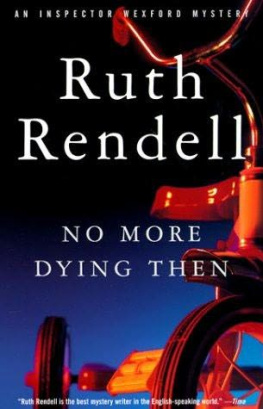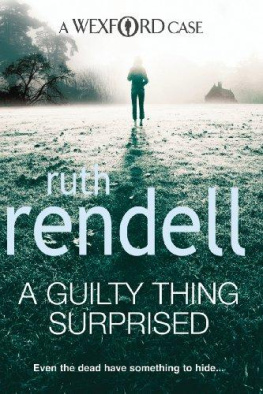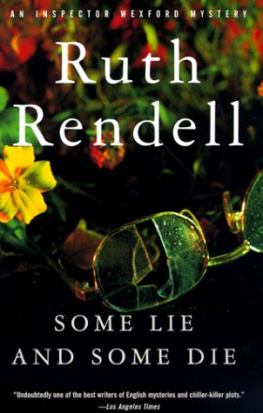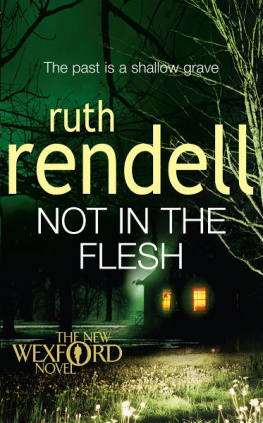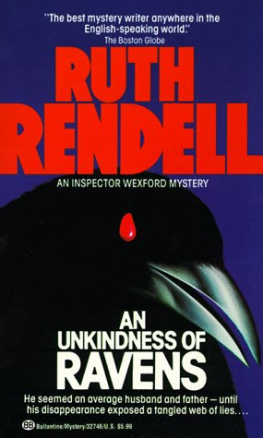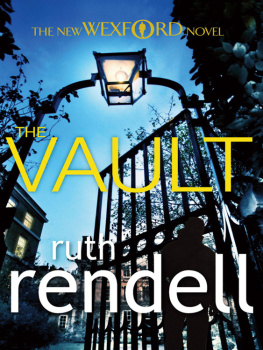Acclaim for
Ruth Rendell
Undoubtedly one of the best writers of English mysteries and chiller-killer plots.
Los Angeles Times
Ruth Rendell is, unequivocally, the most brilliant mystery novelist of our time. Her stories are a lesson in a human nature as capable of the most exotic love as it is of the cruelest murder. She does not avert her gaze and magnificently triumphs in a style that is uniquely hers and mesmerizing.
Patricia Cornwell
Ruth Rendell is a phenomenon.
The New York Times Book Review
Ruth Rendell is one of the best crime novelists working today.
Los Angeles Daily News
No one writes with more devastating accuracy about the world we live and commit sin in today. She is one of our most important novelists.
John Mortimer
Rendells clear, shapely prose casts the mesmerizing spell of the confessional.
The New Yorker
The best mystery writer anywhere in the English-speaking world.
The Boston Globe
Ruth Rendell is a master of the form.
The Washington Post Book World
Rendell writes with such elegance and restraint, with such a literate voice and an insightful mind, that she transcends the mystery genre and achieves something almost sublime.
Los Angeles Times
Ruth Rendell
A Demon in My View
Ruth Rendell is the author of A Sight for Sore Eyes, Road Rage, The Keys to the Street, Bloodlines, Simisola, and The Crocodile Bird. Her most recent novel is Harm Done. She is the winner of the Mystery Writers of America Grandmaster Award. She is also the recipient of three Edgars from the Mystery Writers of America and four Gold Daggers from Englands Crime Writers Association. In 1997 she was named a life peer in the House of Lords. She lives in England.

All of the characters in this book are fictitious, and any resemblance to actual persons, living or dead, is purely coincidental
FIRST VINTAGE BOOKS EDITION, JANUARY 2000
Copyright1976 by Ruth Rendell
All rights reserved under International and Pan-American Copyright Conventions. Published in the United States by Vintage Books, a division of Random House, Inc., New York. Originally published in hardcover in Great Britain by Hutchinson, London, in 1976, and in the United States by Doubleday, a division of Random House, Inc.,
New York, in 1977.
Vintage is a registered trademark, and Vintage Crime/Black Lizard and colophon are trademarks of Random House, Inc.
Library of Congress Cataloging-in-Publication Data
Rendell, Ruth, 1930-
A demon in my view / Ruth Rendell.
p. cm. (Vintage crime/Black Lizard)
eISBN: 978-0-307-55558-8
I. Title. II. Series.
PR6068.E63D46 2000
823.914dc21 99-22589
www.vintagebooks.com
v3.1
For Margaret Rabbs, with love
Contents
Cover
About the Author
Title Page
Copyright
Dedication
Authors Note
Chapter 1
Chapter 2
Chapter 3
Chapter 4
Chapter 5
Chapter 6
Chapter 7
Chapter 8
Chapter 9
Chapter 10
Chapter 11
Chapter 12
Chapter 13
Chapter 14
Chapter 15
Chapter 16
Chapter 17
Chapter 18
Chapter 19
Chapter 20
Chapter 21
Chapter 22
Chapter 23
Authors Note
The Gunpowder Plot was an attempt to assassinate King James I of England and destroy the Houses of Lords and Commons on the day of the opening of Parliament, November 5, 1605. Fuel and explosives were concealed in a cellar under the House of Lords, but the conspirators were betrayed to the government before their design could be carried out. One of their number, Guy Fawkes, was arrested at midnight in the cellar doorway, brought to trial with his fellow conspirators and executed in January 1606.
Although Guy Fawkes met his death by hanging and not by burning at the stake, it has been a tradition with English children to commemorate November 5 by burning him in effigy each year on that date. This custom has never become quaint or mere ceremonial but is very much a part of English life.
From childhoods hour I have not been
As others were; I have not seen
As others saw; I could not bring
My passions from a common spring.
From the same source I have not taken
My sorrow; I could not awaken
My heart to joy at the same tone;
And all I loved, I loved alone.
Thenin my childhood, in the dawn
Of a most stormy lifewas drawn
From every depth of good and ill
The mystery which binds me still
And the cloud that took the form
(When the rest of Heaven was blue)
Of a demon in my view.
Edgar Allan Poe
The cellar was divided into rooms. Each of these caverns except the last of them was cluttered with the rubbish which usually encumbers the cellars of old houses: broken bicycles, old mould-grown leather cases, wooden crates, legless or armless chairs, cracked china vessels, yellowing newspapers bundled up with string, and in heaps, the nameless unidentifiable cylinders and tubes and rods and rings and spirals of metal which once, long ago, bolted or screwed or linked something on to something else. All this rubbish was coated with the thick black grime that is always present in cellars. The place smelt of soot and fungus.
Between the junk heaps a passage had been cleared from the steps to the first doorless doorway, on to the second doorway and thence to the bare room beyond. And in this room, unseen as yet in the pitch blackness, the figure of a woman leaned against the wall.
He came down the steps with a torch in his hand. He switched on the torch only when he had closed and bolted the door behind him. Then, led by its beam, he picked his way softly along the path that was hedged by rubbish. There was no sound but the shuffle of his slippers on the sooty stone, yet as he entered the second room he told himself he had heard ahead of him an indrawn breath, a small gasp of fear. He smiled, though he was trembling, and the hand which held the torch shook a little.
At the second doorway he raised the beam and let it play from the lower left-hand corner of the room upwards and then downwards, moving it languidly towards the right. It showed him pocked walls, a cracked ceiling hung with cobwebs. It showed him old, broken, long-disused electric wires, a trickle of viscous water running from the fissure in a split brick, and then, playing in a downward arc, it showed him the womans figure.
Her white face, beautiful, unmarked by any flaw of skin or feature, stared blankly back at him. But he fancied, as the torch shivered in his hand, that she had cringed, her slim body in its short black dress pressing further into the wall which supported it. A handbag was hooked over one of her arms and she wore scuffed black shoes. He didnt speak. He had never known how to talk to women. There was only one thing he had ever been able to do to women and, advancing now, smiling, he did it.
First he rested the torch on a brick ledge at the level of his knees so that she was in shadow, so that the room took on the aspect of an alley into which a street lamp filters dimly. Then he approached her, paralysed as she was, and meeting no resistancehe would have preferred resistancehe closed his hands on her throat.
Still there was no resistance, but what happened next was almost as satisfactory. His hands squeezed till the fingers met, and as forefinger pressed against thumb, the beautiful white face changed, crumpled, twisted in agony and caved in. He gave a grunting gasp as her body fell sideways. He released his hold, swaying at the earthquake inside him, and he let her fall, prone and stiff, into the footmarked soot.
Next page

